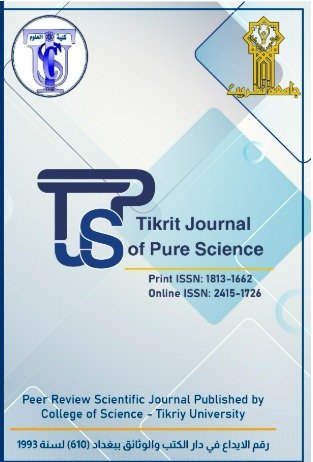Structural and Optical Properties for ZnO Nanoparticles for Antibacterial Application
Main Article Content
Abstract
In this research, ZnO nanoparticles were prepared by pulsed laser ablation in liquid (PLAL) technique. The X-Ray diffraction (XRD) test was used to find out the crystal structure of ZnO and its crystal size, the result is that the creation of ZnO NPs has a polycrystalline structure of hexagonal phases. As for an atomic force microscopy (AFM) analysis, AFM 3D pictures show that the surface roughness are increase with increase the laser energy. The UV-visible device test was conducted to determine the optical properties, and it was revealed that the maximum absorption appears to occur at (400 nm). By changing the laser energy discovered that when laser intensity increased, the ZnO NPs' bandgap decreases. ZnO has been used in antibacterial applications, The result of laser manufactured ZnO Nanoparticles was verified for its antibacterial activities at gram- positive (Staphylococcus aureus).
Article Details

This work is licensed under a Creative Commons Attribution 4.0 International License.
Tikrit Journal of Pure Science is licensed under the Creative Commons Attribution 4.0 International License, which allows users to copy, create extracts, abstracts, and new works from the article, alter and revise the article, and make commercial use of the article (including reuse and/or resale of the article by commercial entities), provided the user gives appropriate credit (with a link to the formal publication through the relevant DOI), provides a link to the license, indicates if changes were made, and the licensor is not represented as endorsing the use made of the work. The authors hold the copyright for their published work on the Tikrit J. Pure Sci. website, while Tikrit J. Pure Sci. is responsible for appreciate citation of their work, which is released under CC-BY-4.0, enabling the unrestricted use, distribution, and reproduction of an article in any medium, provided that the original work is properly cited.
References
1. Jebur KH, Mohammed NJ. Dependence of the Structural and Optical Properties of Gallium Oxide Nanostructures on Laser Fluency. Al-Mustansiriyah Journal of Science. 2021;32(4):60-6.
2. Balachandran A, Sreenilayam SP, Madanan K, Thomas S, Brabazon D. Nanoparticle production via laser ablation synthesis in solution method and printed electronic application-A brief review. Results in Engineering. 2022; 16:100646. https://doi.org/10.1016/j.rineng.2022.100646
3. Fouad H, Yang G, El-Sayed AA, Mao G, Khalafallah D, Saad M, et al. Green synthesis of AgNP–ligand complexes and their toxicological effects on Nilaparvata lugens. Journal of nanobiotechnology. 2021;19:1-17. https://doi.org/10.1186/s12951-021-01068-z
4. Willander M, Nur O. Nanobiology and nanomedical devices using zinc oxide nanostructures. Zinc Oxide Nanostructures: Advances and Applications. 2014:127.
5. Jaber GS, Khashan KS, Abbas MJ, editors. Study the characteristics optical and structure properties of ZnO-nanoparticles fabricated by laser ablation in liquid. Journal of Physics: Conference Series; 2021: IOP Publishing. https://iopscience.iop.org/article/10.1088/1742-6596/1795/1/012004
6. Bhunia AK. ZnO nanoparticles: Recent biomedical applications and interaction with proteins. Curr Trends Biomed Eng Biosci. 2017;6(1). http://dx.doi.org/10.19080/CTBEB.2017.06.555676
7. Rashid TM, Nayef UM, Jabir MS, Mutlak FA-H. Synthesis and characterization of Au: ZnO (core: shell) nanoparticles via laser ablation. Optik. 2021;244:167569. https://doi.org/10.1016/j.ijleo.2021.167569
8. Radičić R, Maletić D, Blažeka D, Car J, Krstulović N. Synthesis of silver, gold, and platinum doped zinc oxide nanoparticles by pulsed laser ablation in water. Nanomaterials. 2022;12(19):3484. https://doi.org/10.3390/nano12193484
9. Ahmed BS, Mohammad SJ, Mohammed GH. The Effect of Laser Energy on the Structural, Optical and Electrical Properties of CdO Nanomaterials Generated Using (PLD) Technology, and Fabrication a Gas Sensor. Tikrit Journal of Pure Science. 2024;29(1):107-18. https://doi.org/10.25130/tjps.v29i1.1451
10. Faisal S, Jan H, Shah SA, Shah S, Khan A, Akbar MT, et al. Green synthesis of zinc oxide (ZnO) nanoparticles using aqueous fruit extracts of Myristica fragrans: their characterizations and biological and environmental applications. ACS omega. 2021;6(14):9709-22. https://doi.org/10.1021/acsomega.1c00310?rel=cite-as&ref=PDF&jav=VoR
11. Mandal AK, Katuwal S, Tettey F, Gupta A, Bhattarai S, Jaisi S, et al. Current research on zinc oxide nanoparticles: synthesis, characterization, and biomedical applications. Nanomaterials. 2022;12(17):3066. https://doi.org/10.3390/nano12173066
12. Mohammed NJ, Dagher HF. Synthesis and characterization of mercuric sulfide nanoparticles thin films by Pulsed Laser Ablation (PLA) in Distilled Water (DW). Thin Films Laboratory, College of Science, Mustansiriyah University, Baghdad, Iraq. 2020. http://dx.doi.org/10.22068/ijmse.17.3.11
13. Srikanth C, Madhu GM, Bhamidipati H, Srinivas S. The effect of CdO–ZnO nanoparticles addition on structural, electrical and mechanical properties of PVA films. AIMS Materials Science. 2019;6(6):1107-23. https://doi.org/10.3934/matersci.2019.6.1107
14. Omar ST, Ali WK, Karim AS. The Effects of Zinc Oxide nanoparticles synthesized from Eucalyptus plant extracts against mealworm stages Tenebrio molitor L., 1758 (Tenebrionidae: Coleopetera). Tikrit Journal of Pure Science. 2023;28(6):11-24. https://doi.org/10.25130/tjps.v28i6.1374
15. Abdelghani GM, Ahmed AB, Al-Zubaidi AB. Synthesis, characterization, and the influence of energy of irradiation on optical properties of ZnO nanostructures. Scientific Reports. 2022;12(1):20016. https://doi.org/10.1038/s41598-022-24648-x
16. Aldwayyan A, Al-Jekhedab F, Al-Noaimi M, Hammouti B, Hadda T, Suleiman M, et al. Synthesis and characterization of CdO nanoparticles starting from organometalic dmphen-CdI2 complex. International Journal of Electrochemical Science. 2013;8(8):10506-14. https://doi.org/10.1016/S1452-3981(23)13126-9
17. Abdulrahman NBA, Nssaif ZM. Antimicrobial activity of zinc oxide, titanium dioxide and silver nanoparticles against mithicillin-resistant Staphylococcus aureus Isolates. Tikrit Journal of Pure Science. 2016;21(3):49-53. https://doi.org/10.25130/tjps.v21i3.995
18. Mendes CR, Dilarri G, Forsan CF, Sapata VdMR, Lopes PRM, de Moraes PB, et al. Antibacterial action and target mechanisms of zinc oxide nanoparticles against bacterial pathogens. Scientific reports. 2022;12(1):2658. https://doi.org/10.1038/s41598-022-06657-y
19. Al-Fakeh MS, Alsaedi RO, Amiri N, Allazzam GA. Synthesis, characterization, and antimicrobial of MnO and CdO nanoparticles by using a calcination method. Coatings. 2022;12(2):215. https://doi.org/10.3390/coatings12020215
20. C. Naik M, H. Kini J, BE KS, Velho-Pereira S. Sensor and antibacterial research of Mussaenda frondosa leaf extract assisted zinc oxide nanoparticles. Sensing Technology. 2024;2(1):2385839. https://doi.org/10.1080/28361466.2024.2385839
